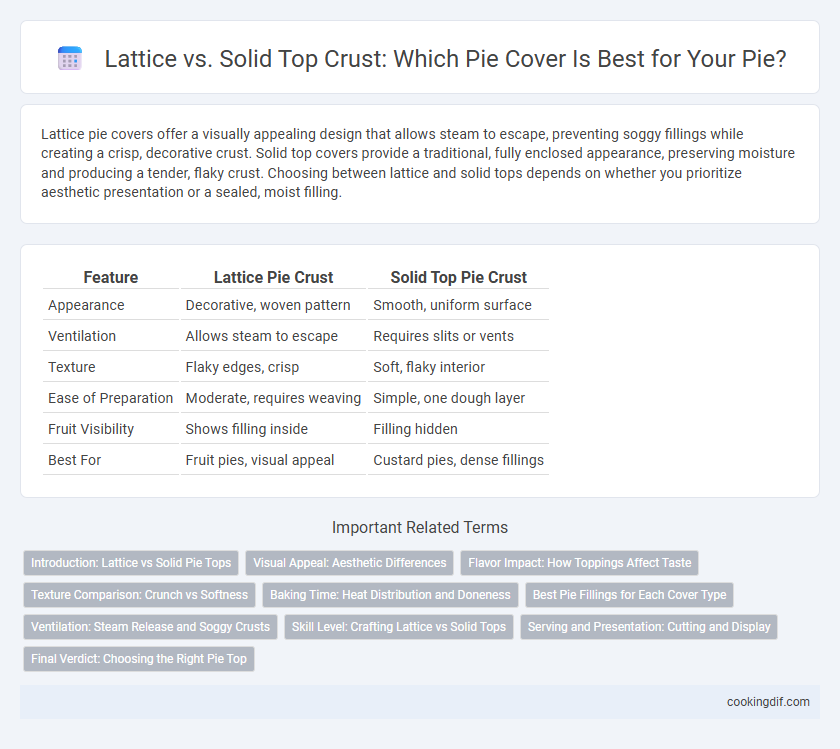Lattice pie covers offer a visually appealing design that allows steam to escape, preventing soggy fillings while creating a crisp, decorative crust. Solid top covers provide a traditional, fully enclosed appearance, preserving moisture and producing a tender, flaky crust. Choosing between lattice and solid tops depends on whether you prioritize aesthetic presentation or a sealed, moist filling.
Table of Comparison
| Feature | Lattice Pie Crust | Solid Top Pie Crust |
|---|---|---|
| Appearance | Decorative, woven pattern | Smooth, uniform surface |
| Ventilation | Allows steam to escape | Requires slits or vents |
| Texture | Flaky edges, crisp | Soft, flaky interior |
| Ease of Preparation | Moderate, requires weaving | Simple, one dough layer |
| Fruit Visibility | Shows filling inside | Filling hidden |
| Best For | Fruit pies, visual appeal | Custard pies, dense fillings |
Introduction: Lattice vs Solid Pie Tops
Lattice pie tops feature a crisscross pattern of dough strips that allow steam to escape and showcase the fruit filling, enhancing both texture and visual appeal. Solid pie tops provide a protective, golden-brown crust that seals in moisture and intensifies the pie's flavor. Choosing between lattice and solid tops affects baking time, texture, and overall presentation, making it essential to consider the type of pie and desired outcome.
Visual Appeal: Aesthetic Differences
Lattice pie covers feature an intricate, woven design that allows steam to escape while showcasing the colorful filling, enhancing visual appeal with a rustic and artisanal look. Solid top pies present a smooth, uniform crust that offers a classic, polished finish, often decorated with cut-out shapes or patterns to add subtle elegance. Choosing between lattice and solid tops depends on the desired aesthetic impact, with lattice tops emphasizing texture and openness, and solid tops providing a clean, traditional appearance.
Flavor Impact: How Toppings Affect Taste
Lattice pie covers allow steam to escape, preserving the pie's natural fruit flavor while adding a subtle caramelized crispness to the topping. Solid top crusts trap moisture, creating a more tender, pie-like texture with concentrated fruit juices underneath, enhancing the richness of the filling. The choice between lattice and solid top directly influences the balance between crust texture and the intensity of the pie's flavor profile.
Texture Comparison: Crunch vs Softness
Lattice pie tops offer a crisp, crunchy texture as the woven dough bakes to a golden, slightly flaky finish, creating a contrast to the softer, moist filling beneath. Solid tops provide a tender, soft crust that traps steam, resulting in a more uniform, cake-like softness throughout the pie's surface. Choosing between lattice and solid top affects the mouthfeel, balancing crunchiness with the gentle chewiness preferred in different pie varieties.
Baking Time: Heat Distribution and Doneness
Lattice pie covers allow steam to escape through the open gaps, promoting even heat distribution and preventing sogginess, which often results in a shorter baking time and crispier crust. Solid top covers trap moisture, creating a steamier environment that can extend baking time and may require adjustments to ensure the filling is fully cooked without overbaking the crust. Optimal doneness depends on balancing these factors, with lattice tops favored for fruit pies needing caramelization and solid tops suitable for cream or custard pies requiring gentle heat.
Best Pie Fillings for Each Cover Type
Lattice pie crusts excel with fruit fillings like apple, cherry, and blueberry, allowing steam to escape and juices to thicken evenly while creating a visually appealing pattern. Solid top crusts are ideal for thick, rich fillings such as pumpkin or pecan, which retain moisture and develop a smooth, custard-like texture under an enclosed cover. Choosing the right cover type enhances both the texture and presentation, ensuring optimal baking results for specific pie fillings.
Ventilation: Steam Release and Soggy Crusts
Lattice pie covers provide superior ventilation by allowing steam to escape freely through the gaps, preventing soggy crusts and ensuring a crisp, flaky texture. Solid top pie covers trap steam inside, increasing moisture and often resulting in a soggy bottom crust. Proper steam release through a lattice design helps maintain the ideal balance of moisture and crispness in baked pies.
Skill Level: Crafting Lattice vs Solid Tops
Creating a lattice pie top requires moderate to advanced crafting skills due to the need for evenly cutting and weaving dough strips for an aesthetically pleasing and functional design. Solid tops are more beginner-friendly, demanding simple rolling and trimming without intricate pattern work. Skilled bakers often prefer lattice tops to showcase filling and add decorative texture, while solid tops offer a faster, more uniform finish.
Serving and Presentation: Cutting and Display
A lattice pie top offers a visually appealing presentation by showcasing the filling through its woven design, making it easier to identify the flavor before serving. Its structure allows steam to escape during baking, which helps maintain a crisp crust that cuts cleanly without sogginess. In contrast, a solid top creates a uniform, golden-brown surface that supports decorative venting but may require extra care to cut neatly due to its denser crust, potentially affecting the display of the filling during serving.
Final Verdict: Choosing the Right Pie Top
Lattice pie tops offer a visually appealing, airy design that allows steam to escape, preventing soggy crusts while showcasing the pie filling. Solid tops provide a classic, sealed finish that locks in moisture and delivers a more uniform texture, ideal for fruit pies needing a softer, steam-cooked filling. The final verdict depends on your preference for crust texture and presentation: choose lattice for a crisp, decorative top and solid for a traditional, tender crust.
Lattice vs solid top for pie covers Infographic

 cookingdif.com
cookingdif.com